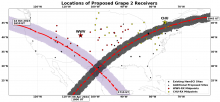HamSCI to Use Grape Personal Space Weather Stations to Study the 2023 and 2024 Solar Eclipses
HamSCI to Use Grape Personal Space Weather Stations to Study the 2023 and 2024 Solar Eclipses

The HamSCI teams at the University of Scranton W3USR and Case Western Reserve University W8EDU were recently awarded a 3-year collaborative National Science Foundation grant to study impacts of the 2023 and 2024 Solar Eclipses on the ionosphere, as well as ionospheric variability that occurs during every day dawn and dusk. The project will be led by Nathaniel Frissell, W2NAF at Scranton and David Kazdan AD8Y, John Gibbons N8OBJ, Rachel Boedicker AC8XY, and Christian Zorman at Case Western. Kristina Collins KD8OXT, Bill Engelke AB4EJ, Steve Cerwin WA5FRF, Phil Erickson W1PJE, Mary Lou West KC2NMC, Bob Gerzoff WK2Y, Rachel Frissell W2RUF, and the entire HamSCI Grape Personal Space Weather Station team played a significant role in winning this grant. NSF funding will provide for about thirty Personal Space Weather Station Grape receivers to be deployed throughout North America. Their locations will be optimized to study the ionospheric impacts simultaneously received from WWV (Fort Collins, CO) on 5 and 10 MHz and CHU (Ottawa, Canada) on 3.33, 7.85, or 14.67 MHz. The HamSCI amateur radio community will be able purchase and field additional stations. All stations will run continuously from deployment through at least the end of the project, and will capture the 2023 and 2024 eclipses. If you would like to participate, please join our Google Group and weekly Grape telecons!
Understanding ionospheric variability remains a frontier topic in the space physics community. This variability is key not only to understanding ionospheric dynamics in its own right, but also as a means to understanding the coupled geospace system as a whole. This project will study ionospheric variability across the continental United States generated by two important classes of geophysical events: dawn/dusk transitions and solar eclipses. Dawn and dusk are daily events with predictable changes in insolation, and yet these events produce a complex response in observed ionospheric variability that is still not completely understood. Solar eclipses are not only stunning visual displays, but also dramatically affect the ionosphere in ways that are both similar to and different from dawn and dusk. During the course of this project, an annular solar eclipse will take place on 14 October 2023 and a total solar eclipse will take place on 8 April 2024. Both eclipses have paths that sweep across the continental United States (CONUS). These are the last solar eclipses to traverse the CONUS until 2044, and are therefore important, time-sensitive, information rich opportunities for running unique and “controlled” ionospheric experiments.
